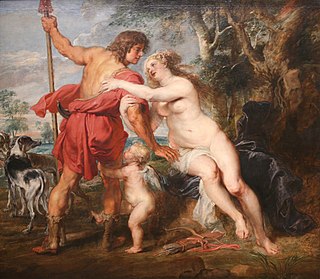
The Baroque is a style of architecture, music, dance, painting, sculpture and other arts that flourished in Europe from the early 17th century until the 1740s. In the territories of the Spanish and Portuguese empires including the Iberian Peninsula it continued, together with new styles, until the first decade of the 1800s. It followed Renaissance art and Mannerism and preceded the Rococo and Neoclassical styles. It was encouraged by the Catholic Church as a means to counter the simplicity and austerity of Protestant architecture, art and music, though Lutheran Baroque art developed in parts of Europe as well.

Rococo, less commonly Roccoco or Late Baroque, is an exceptionally ornamental and theatrical style of architecture, art and decoration which combines asymmetry, scrolling curves, gilding, white and pastel colors, sculpted molding, and trompe l'oeil frescoes to create surprise and the illusion of motion and drama. It is often described as the final expression of the Baroque movement.

Neoclassicism was a Western cultural movement in the decorative and visual arts, literature, theatre, music, and architecture that drew inspiration from the art and culture of classical antiquity. Neoclassicism was born in Rome largely thanks to the writings of Johann Joachim Winckelmann, at the time of the rediscovery of Pompeii and Herculaneum, but its popularity spread all over Europe as a generation of European art students finished their Grand Tour and returned from Italy to their home countries with newly rediscovered Greco-Roman ideals. The main Neoclassical movement coincided with the 18th-century Age of Enlightenment, and continued into the early 19th century, laterally competing with Romanticism. In architecture, the style continued throughout the 19th, 20th and up to the 21st century.

The art of Europe, or Western art, encompasses the history of visual art in Europe. European prehistoric art started as mobile Upper Paleolithic rock and cave painting and petroglyph art and was characteristic of the period between the Paleolithic and the Iron Age. Written histories of European art often begin with the art of the Ancient Middle East and the Ancient Aegean civilizations, dating from the 3rd millennium BC. Parallel with these significant cultures, art of one form or another existed all over Europe, wherever there were people, leaving signs such as carvings, decorated artifacts and huge standing stones. However a consistent pattern of artistic development within Europe becomes clear only with the art of Ancient Greece, adopted and transformed by Rome and carried; with the Roman Empire, across much of Europe, North Africa and the Middle East.
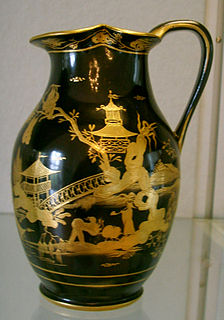
Chinoiserie is the European interpretation and imitation of Chinese and other East Asian artistic traditions, especially in the decorative arts, garden design, architecture, literature, theatre, and music. The aesthetic of Chinoiserie has been expressed in different ways depending on the region. Its acknowledgement derives from the current of Orientalism, which studied Far East cultures from a historical, philological, anthropological, philosophical and religious point of view. First appearing in the 17th century, this trend was popularized in the 18th century due to the rise in trade with China and the rest of East Asia.
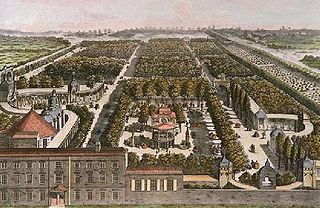
Vauxhall Gardens is a public park in Kennington, London, England, on the south bank of the River Thames.
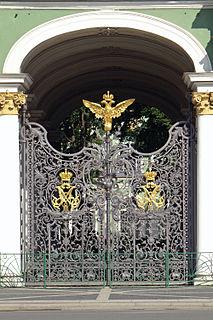
Ironwork is any weapon, artwork, utensil or architectural feature made of iron especially used for decoration. There are two main types of ironwork: wrought iron and cast iron. While the use of iron dates as far back as 4000BC, it was the Hittites who first knew how to extract it and develop weapons. Use of iron was mainly utilitarian until the Middle Ages, it became widely used for decoration in the period between the 16th and 19th century.

Neoclassical architecture is an architectural style produced by the Neoclassical movement that began in the mid-18th century in Italy and France.

Rocky Rococo Pizza and Pasta is a chain of North American restaurants that specializes in pan-style pizza sold by the slice. It was founded in Madison, Wisconsin, in 1974 by a pair of college students who took the name from a character invented in 1969 by the Firesign Theatre. The Firesign Theatre claimed ownership of the name and threatened legal action in 1985, but according to legal precedent set by a similar case in Austin, Texas, they had weakened their case for copyright infringement in a 1975 visit to the first Rocky Rococo store, when they gave the owners autographed pictures, which implied their approval of the name use. The chain grew as large as 120 stores in 1986, and the owners sold the franchise rights to another partner and group of investors in 1988. Today there are still 40 locations in the Midwest.

French architecture consists of numerous architectural styles that either originated in France or elsewhere and were developed within the territories of France.

Holy Trinity Chapel is a private chapel adjacent to Capesthorne Hall, near the village of Siddington, Cheshire, England. It is recorded in the National Heritage List for England as a designated Grade II* listed building. It is an Anglican church in the diocese of Chester, the archdeaconry of Macclesfield and the deanery of Macclesfield. Its benefice is combined with those of St James and St Paul, Marton, Christ Church, Eaton, and All Saints, Siddington.

St Leonard's Church is in the village of Warmingham, Cheshire, England. The church is recorded in the National Heritage List for England as a designated Grade II* listed building. It is an active Anglican parish church in the diocese of Chester, the archdeaconry of Macclesfield and the deanery of Congleton. Its benefice is combined with that of St Peter, Minshull Vernon.

Holy Trinity Church is in the centre of the town of Warrington, Cheshire, England. The church is recorded in the National Heritage List for England as a designated Grade II* listed building. It is an active Anglican parish church in the diocese of Liverpool, the archdeaconry of Warrington and the deanery of Warrington.

The Santa Maria Maddalena is a Roman Catholic church in Rome, named after Saint Mary Magdalene. It is located on the Via della Maddalena, one of the streets leading from the Piazza della Rotonda in the Campo Marzio area of historic Rome.
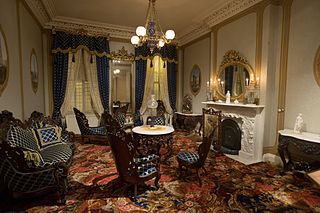
The Rococo Revival style emerged in Second Empire France and then was adapted in England. Revival of the rococo style was seen all throughout Europe during the 19th century within a variety of artistic modes and expression including decorative objects of art, paintings, art prints, furniture, and interior design. In much of Europe and particularly in France, the original rococo was regarded as a national style, and to many, its reemergence recalled national tradition. Rococo revival epitomized grandeur and luxury in European style and was another expression of 19th century romanticism and the growing interest and fascination with natural landscape.

A shell grotto is a type of folly, a grotto decorated with sea shells. The shell grotto was a popular feature of British country house in the 17th and 18th centuries. It suited the Baroque and Rococo styles and often represented the mimicry of architectural features from the Italian Renaissance. The idea of a grotto was originally a means to enhance a dank undercroft, or provide an antechamber before a piano nobile, but later it became a garden feature independent of the house, sometimes on the edge of a lake, with water flowing through it.
In the 18th century, the Spanish Baroque was moving towards a more ornate style. Sculpture, painting and carving blended with the architecture, sometimes to encourage classical architectural schemes that remain in force in floors and elevations. Facing the outside, usually austere, are creates vibrant interiors. This late-Baroque which employs profusely ornamental motifs as acanthus leaf, of Classical roots, begins to soak in the 1730s from the influence of French Rococo, exemplified mainly in the dissemination of a new decorative motif: the rocaille, consisting of complicated sets of "C" and "S" that generate asymmetrical shapes and also remind marine forms. The rocaille became known in Spain through three main ways: dissemination through the pattern books, the importation of furniture and other decorative arts from Europe and its direct brought hand of foreign architects, case of the Portuguese Cayetano de Acosta.
Rocky Rococo may refer to:

Shobdon Court was an 18th-century English country house in the village of Shobdon, near Leominster, Herefordshire. Although the main house has since been demolished, the service wing and the stable block have been converted to residential use.

The Guildhall is a municipal facility at Register Square in Beverley, East Riding of Yorkshire, England. It is a Grade I listed building.

















